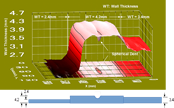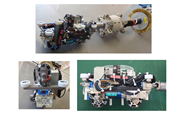Classification
5 - B
Flow Accelerated Corrosion (FAC) of carbon steel (CS) piping is one of main issues in secondary system of Pressurized Water Reactor (PWR) nuclear power plant. Wall thinning of CS piping due to FAC increases potential risk of pipe rupture, cost for inspection and replacement of damaged pipes.
In Tsuruga Unit 2 (PWR, 1160MWe) secondary system, high pH control by All Volatile Treatment (High-AVT), using ammonia as alkaline agents and hydrazine as an oxygen scavenger, has been adopted to mitigate the corrosion of CS by forming passive film of magnetite (Fe3O4) on CS surface. Though High-AVT is useful to suppress the whole surface corrosion in PWR secondary system, magnetite film created by High-AVT has a limit to suppress the local corrosion such as FAC.
Previous studies have shown applicability and effectiveness of Oxygenated Water Chemistry (OWC) as a new approach to FAC suppression for PWR secondary system. [1] [2] OWC produces more defensive film of hematite (Fe2O3) on the surface of CS and is effective to mitigate FAC.
Based on these studies, OWC has been applied to condensate system in Tsuruga Unit 2 from Jan. 2011. Fig.1 shows the OWC setup in secondary loop. Oxygen is injected to condensate demineralizer outlet, and electrochemical corrosion potential (ECP) electrodes were installed in deaerator inlet, high pressure heat exchanger (HPH) inlet and HPH outlet. Stainless steel (SS) working electrodes were installed in HPH inlet and outlet in order to estimate dissolved oxygen (DO) concentration in each point. And, CS working electrode was installed in deaerator inlet and HPH inlet to estimate the properties of oxide film on CS surface. And, to evaluate the FAC mitigation effect of OWC, wall thickness of actual condensate piping in Tsuruga Unit 2 after OWC application was measured by continuous monitoring system, using high-temperature and high-resolution ultrasonic probe. Fig.2 shows an outline of the continuous monitoring system. These continuous monitoring systems were installed to the piping located at deaerator inlet where FAC was the most severe in condensate system in Tsuruga Unit 2. The details of these monitoring points are shown in Fig.3.

Fig. 1 Schematic diagram of the facilities for OWC in Tsuruga Unit 2

Fig. 2 Outline of continuous wall thickness monitoring system with high-temperature and high-resolution ultrasonic probe

Fig. 3 Details of continuous wall thickness monitoring points by high-temperature and high-resolution ultrasonic probe
Phase 3 : Publicly accepted phase
- (1) Components: Piping in PWR secondary cooling system, e.g. condensate and feed water systems.
- (2) Material: Carbon steel
- (1)Very small amount of oxygen
The FAC is suppressed by forming hematite film on the CS surface even under extremely low DO concentration such as 2ppb in PWR secondary coolant under High-AVT condition.
JAPC conducted OWC at condensate system of Tsuruga Unit 2. Table 1 shows the test matrix to verify the FAC mitigation effect of OWC. ECP and the wall thickness were measured continuously and pH and DO concentration of condensate were changed step by step according to the matrix.
Fig.4 shows behavior of DO concentration, pH and ECP in condensate system. ECP of SS in deaerator inlet rose drastically according to increase of the oxygen injection rate. On the other hand, ECP of CS in deaerator inlet became instable during Step 3. This behavior shows that the hematite film could not be formed on CS surface under 2ppb DO concentration under low pH control by All Volatile Treatment (Low- AVT) condition (Feedwater pH 9.3). And, ECP of CS in deaerator inlet rose to over -0.2V vs. SHE and stabilized when DO was increased to more than 5ppb under Low-AVT condition. It means the required DO concentration to make hematite film on CS surface stably is more than 5ppb under the Low-AVT condition. By contrast, under the High-AVT condition (Step6), ECP of CS in deaerator inlet was stable in more than -0.2V even in the 2ppb DO concentration. It means the required DO concentration to make hematite film on CS surface stably is more than 2ppb under the High-AVT condition.
Changes of wall thickness of CS piping observed by using continuous wall thickness monitoring system are shown in Fig.5. As will be noted from this figure, it is difficult to read the wall thickness quantitatively because of relatively large amount of signal noises. But a trend of the change of wall thickness based on signal intensity, i.e. FAC mitigation effect, can be read. Under low Low-AVT condition, FAC were mitigated by more than 5ppb of oxygen at both Location A and B (Step4, 5). Consequently, required DO concentration to FAC mitigation is more than 5ppb under Low-AVT condition with pH 9.3. On the other hand, FAC were almost stopped even in 2ppb of oxygen at both Location A and B under High-AVT condition (Step6). Consequently, required DO concentration to FAC mitigation is more than 2ppb under High-AVT condition with pH 9.8. This trend is well in agreement with ECP measurement result, and shows that the hematite formation on CS surface is effective for FAC mitigation.
The test (Step7, 8) will be continued and details of FAC mitigation effect of OWC are due to be evaluated. Moreover, we are considering applying OWC to feed water system in the future.
Table1 Test matrix to find out the most suitable water chemistry to mitigate FAC in PWR secondary system


Fig.4 Behavior of Oxygen concentration, pH and ECP in condensate system

Fig.5 Change of wall thickness of CS piping observed by using continuous wall thickness monitoring system during OWC
- [1]H. Takiguchi, Oxygenated Water Chemistry for PWR Secondary System – New Approach to FAC -, Proceeding of NPC’08, Berlin, Germany, September 2008
- [2]W. Sugino et.al., Effect of Water Chemistry Improvement on Flow-Accelerated Corrosion in PWR Secondary Systems, PowerPlant Chemistry 2010, 12(11)
- [3]W. Sugino et.al., Effectiveness of Oxygen Treatment on Flow Accelerated Corrosion Mitigation in PWR Secondary System, Proceeding of NPC’12, Paris, France, September 2012
Japan Society of Maintenology (ejam@jsm.or.jp)





